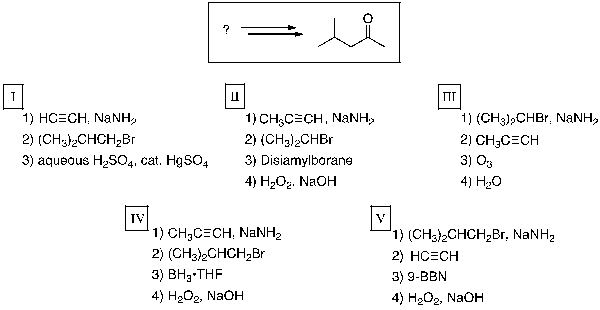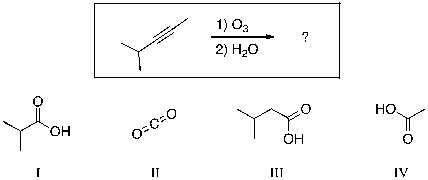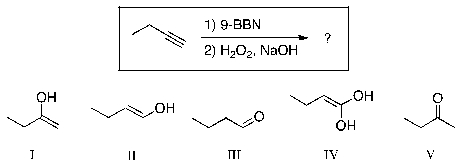A) 1-bromo-1-pentene
B) 2-bromo-1-pentene
C) 1,1-dibromopentane
D) 2,2-dibromopentane
E) 1,2-dibromopentane
Correct Answer

verified
Correct Answer
verified
Multiple Choice
Which of the following alkynes, upon ozonolysis, would be expected to produce only one major organic product?
A) 1-Hexyne
B) 2-Hexyne
C) 3-Hexyne
D) 2-Heptyne
E) 3-Heptyne
Correct Answer

verified
Correct Answer
verified
Multiple Choice
Which sequence of reactions is expected to produce the product below as the final, and major, organic product? 
A) 1) H2, Lindlar's cat.; 2) OsO4; 3) NaHSO3/H2O
B) 1) H2, Pt; 2) OsO4; 3) NaHSO3/H2O
C) 1) OsO4; 2) NaHSO3/H2O; 3) H2, Lindlar's cat.
D) 1) Na, NH3(l) ; 2) OsO4; 3) NaHSO3/H2O
E) 1) OsO4; 2) NaHSO3/H2O; 3) Na, NH3(l)
Correct Answer

verified
Correct Answer
verified
Multiple Choice
What is the IUPAC name for di-sec-butylacetylene?
A) 2-ethyl-5-methyl-3-heptyne
B) 2,7-dimethyl-4-octyne
C) 3,6-dimethyl-4-octyne
D) 2,5-diethyl-3-hexyne
E) 2,2,5,5-tetramethyl-3-hexyne
Correct Answer

verified
Correct Answer
verified
Multiple Choice
What is the IUPAC name for the expected product of the transformation below? 
A) Propyne
B) 1-Hexyne
C) 2-Hexyne
D) 3-Hexyne
E) (E) -3-Hexyne
Correct Answer

verified
Correct Answer
verified
Multiple Choice
Which alkyne would produce the products below upon ozonolysis? 
A) HC≡CC≡CCH2C≡CH
B) HC≡CCH2CH2CH2C≡CH
C) CH3C≡CCH2C≡CCH3
D) HC≡CCH2CH2C≡CCH3
E) CH3C≡CC≡CC≡CH
Correct Answer

verified
Correct Answer
verified
Multiple Choice
What is the IUPAC name for diisobutylacetylene?
A) diisopropylbutyne
B) 2,7-dimethyl-4-octyne
C) 3,6-dimethyl-4-octyne
D) 2,5-diethyl-3-hexyne
E) 2,2,5,5-tetramethyl-3-hexyne
Correct Answer

verified
Correct Answer
verified
Multiple Choice
Determine which compound will react with sodium in liquid ammonia to form trans-3-hexene.
A) cis-3-hexene
B) trans-2-hexene
C) 3-hexyne
D) 2-hexyne
E) cis-2-hexene
Correct Answer

verified
Correct Answer
verified
Multiple Choice
Which of the reagents below would convert 2-pentyne to trans-2-pentene?
A) NaNH2, NH3
B) Na, NH3
C) H2, Lindlar's catalyst
D) H2, Pd/C
E) H2O, HgSO4/H2SO4
Correct Answer

verified
Correct Answer
verified
Multiple Choice
Which sequence of reactions is expected to produce the product below as the final, and major, organic product? 
A) I
B) II
C) III
D) IV
E) V
Correct Answer

verified
Correct Answer
verified
Multiple Choice
What is the expected major product of the reaction sequence shown below? HC≡C:- + (CH3) 2CHCH2Br ?
A) CH≡CH + (CH3) 2CHC≡CH
B) (CH3) 2CHC≡CCH3
C) (CH3) 2CHCH2C≡CH
D) (CH3) 2CHCHBrC≡CH
E) CH3CHCH2C≡CCH3
Correct Answer

verified
Correct Answer
verified
Multiple Choice
Predict the major organic products of the reaction below. 
A) I and II
B) II an III
C) I and IV
D) II and III
E) 1 and III
Correct Answer

verified
Correct Answer
verified
Multiple Choice
What is the IUPAC name for the molecule shown below? 
A) 6-bromo-3-octyne
B) 6-bromo-6-methyl-3-heptyne
C) 2-bromo-2-methyl-4-heptyne
D) 6-bromo-6,6-dimethyl-3-hexyne
E) 2-bromo-4-octyne
Correct Answer

verified
Correct Answer
verified
Multiple Choice
Select the alkyne listed below that, upon treatment with ozone followed by water, would not produce carbon dioxide and a carboxylic acid as the final products?
A) Ethyne
B) Propyne
C) 1-Butyne
D) 1-Pentyne
E) 1-Hexyne
Correct Answer

verified
Correct Answer
verified
Multiple Choice
What is the IUPAC name for the molecule shown below? 
A) 4,4-dimethyl-2-pentyne
B) 2,2-dimethyl-4-heptyne
C) 1-tert-butyl-3-heptyne
D) 6,6-dimethyl-3-heptyne
E) 6,6,6-trimethyl-3-hexyne
Correct Answer

verified
Correct Answer
verified
Multiple Choice
In an acid-catalyzed hydration, which of the following alkynes is expected to produce a single ketone?
A) 2-decyne
B) 3-decyne
C) 4-decyne
D) 5-decyne
E) All of the above will give a single product
Correct Answer

verified
Correct Answer
verified
Multiple Choice
For the reaction shown, which of the compounds below would be the expected major, and final, organic product? 
A) I
B) II
C) III
D) IV
E) V
Correct Answer

verified
Correct Answer
verified
Multiple Choice
Which sequence of reagents would be expected to accomplish the transformation shown? 
A) 1) HBr; 2) 2 NaNH2
B) 1) Br2; 2) 2 NaNH2
C) 1) Br2, H2O; 2) NaNH2
D) 1) HBr/ROOR; 2) excess NaNH2
E) 1) Na, NH3(l)
Correct Answer

verified
Correct Answer
verified
Essay
Draw all constitutional isomers of the molecular formula C6H10 that are terminal alkynes.
Correct Answer

verified
Correct Answer
verified
Multiple Choice
For the reaction shown, select the expected major organic product. 
A) I
B) II
C) III
D) IV
E) V
Correct Answer

verified
Correct Answer
verified
Showing 101 - 120 of 166
Related Exams